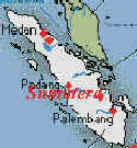
NANGGROE ACEH DARUSSALAM
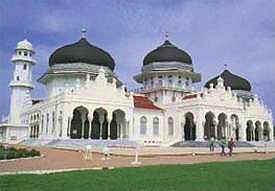
Masjid Raya Baiturrahman, Aceh
Source: www.mweb.co.id/travel/daerah_istimewa_aceh/wisata/
The
capital city of Nanggroe Aceh Darussalam is Banda Aceh. This province is also called
"Serambi Mekah" or the veranda of Mecca, since it is considered as the closest
entry from Mecca to Indonesia. The native people of this province are called the Acehnese,
who are Islam. Unlike in other regions of the country, in Aceh alcohol beverages are
not legally available.
Seudati, meusakat, and ranub lam
puan are some traditional dances from Aceh. Acehnese musical instruments
are made of bamboo, rattan, and horsetail.
This province is very rich with natural
resources such as oil and natural gas.
Traditional heritage of Aceh
Back to the list of provinces
|

NORTH
SUMATRA
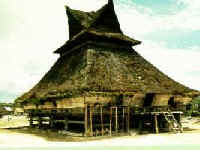
Rumah Adat Batak Karo
Homan, Peter.et.al. 1990. Indonesia in Focus. Netherland: Edu'Actief
Publishing Company.
North Sumatra covers the area of 70,687 sq. km. Medan is the capital city of the
province. It becomes the largest city in Sumatra and the third largest city in
Indonesia. The native people of this province are the Bataks. Other ethnic groups who live
here including Javanese, Acehnese, Arabians, Riau Islanders, Chinese, Indians,
and Melayus. These people migrated to North Sumatra to seek fortune, since the
province has many commercial centers and plantations.
Some sites of interest in this province
are Gang Bangkok Mosque (Medan's oldest mosque), Parisada Hindu Dharma
Temple, Vihara Gunung Timur, Roman Catholic and Protestant churches. In
addition, the capital city of Medan has several buildings in
colonial-styled architectures. These buildings include the central post office and
the Dutch Church.
Traditional heritage of North Sumatra
Back to the list of provinces
|

WEST SUMATRA
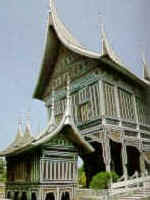
Rumah Gadang
Turner, Peter. et.al. 1995. Indonesia: A Lonely Planet Travel Survival
Kit. Hong Kong: Lonely Planet Publication
The capital city of West Sumatra is Padang. The native ethnic group of this province is
the Minangkabau. Islam is the main religon of the population.
Unlike most ethnic groups in Indonesia
who practice patrilineal system, the Minang people practice matrilineal system, where the
inheritage rights fall to the women. Perhaps that is why many Minangkabau men leave their
villages and work in other places. Usually they open up food vendors and sell Minang
foods. Minang foods are very good but they are very hot and spicy.
"Rumah Gadang" or the "Big House"
is the traditional house of the Minangkabau people. This house has a roof that shaped like
buffalo's horns.
Traditional heritage of West Sumatra
Back to the list of provinces
|

JAMBI

Lake Kerinci
Source: www.jipi.com/inatourism/jambi
The capital city of the Province of Jambi is
Jambi. Most of the region lies along Batanghari River. The languages spoken here are
Malay, Jambi, and Indonesian.
The native people of this province are "Orang Rimba" or the people of the
jungle. Their number in 1998 is about 2,500. Usually the do hunt, gather food from the
forest, and practice slash and burn agriculture.
Other ethnic groups are Kubu, Melayu, Kerinci, Bajau, Batin, and Penghulu.
Traditional dances of this province are Selampit Delapan, Rangkuang, Sekapur Sirih, and
Kisan.
Traditional
heritage of Jambi
Back to the list of provinces
|

SOUTH SUMATRA
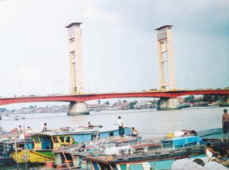
Jembatan Ampera
Source: sonyjogja.tripod.com
The capital city of South Sumatra is
Palembang. Musi River runs in this city. A famous bridge, the Ampera Bridge, spans on this
river. In the past, Palembang was the capital city of the Sriwijaya Kingdom. South
Sumatra is also welknown for its songket and rainbow textiles.
Traditional
heritage of South Sumatra
Back to the list of provinces
|

LAMPUNG
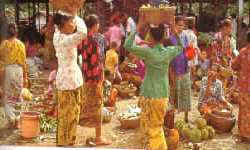
Traditional Market Lampung
Indonesia, Lonely Planet. May 1995
The
province of Lampung lies on the southernmost part of Sumatra
Island. Its capital is Bandar Lampung. This province has many coffee plantations. Krakatau volcano is located in
this province. The port of Bakaheuni in this province and the port of Merak in the
province of Banten connected Sumatra and Java Islands.
Traditional
heritage of Lampung
Back to the list of provinces
|

BENGKULU
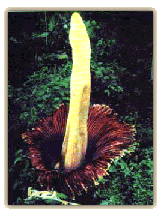
Bunga bangkai
Source
https://202.159.74.163/tourism/
The province of Bengkulu
was established in 1968. The capital city is Bengkulu.
Bengkulu became the location where
Sukarno (the first president of Indonesia) was exiled by the Dutch in 1938. He was
remained there until the arrival of Japanese in 1941. Sukarno designed the Jamik
Mosque.
One of the special events in this
province is the Tabot Festival. It is known as the festival of fifty colorful towers
(tabots), which are made of bamboo and decorated with colored paper. This festival is
attributed to the heroism of Hassan and Hussein, the grandsons of the Prophet
Mohammed. Other interesting places are Panjang Beach and the lake of Dendam Tak
Sudah.
Traditional heritage of Bengkulu
Back to the list of provinces
|

RIAU
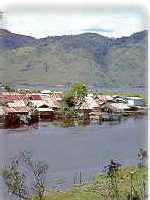
Danau Tawar
Sorey, Robert et.al. 1992. Indonesia: A Travel Survival Kit. Singapore:
Lonely Planet Publication.
The capital city of Riau is Pekan Baru. The native people of this
province are the Malays. Other groups are Batak, Minangkabau, and Chinese.
Riau is a province which consists of many
islands that are scattered across the South China Sea. One of them is Batam Island which
located approximately 30 minutes by boat from Singapore. This island is an industrial
center. Other important island is Bintan Island.
Interesting sites in this province are the old palace
of Raja Ali and the tombs and graveyards of Raja Jaafar.
Traditional heritage of Riau
Back to the list of provinces

|
